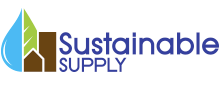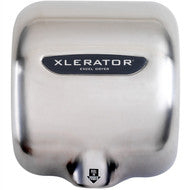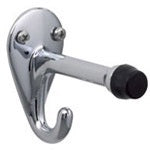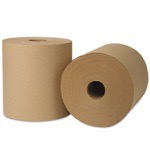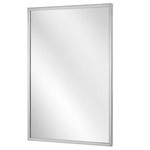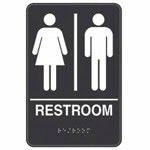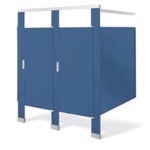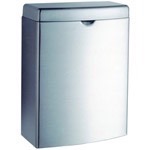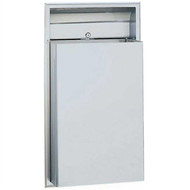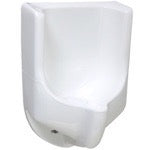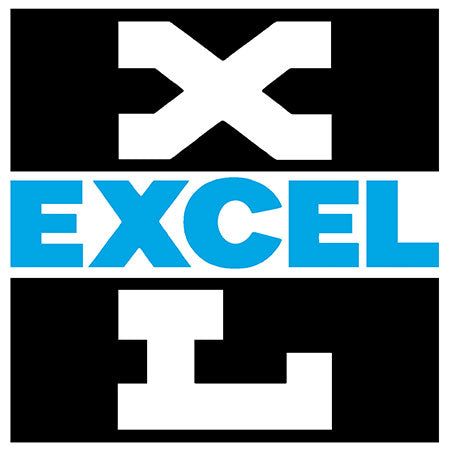Home > Restroom
Restroom Superstore
Commercial Bathroom Supplies: Take advantage of a wide selection from industry-leading manufacturers of all the Restroom products your job specifies.
Quick Ship Products: Usually Ships Same Business Day
Popular Soap Dispensers
Popular Hand Dryers










A Business Case for the Green Restroom
At Sustainable Supply, “going green” means high-efficiency, human health, and environmental sustainability, it’s that simple. And there is no better place in your facility for going green than the restroom.
Choosing the products for your new restroom can be a real ho-hum kind of event. What do you need? Toilets. Urinals. Sinks. Faucets. Partitions. Hand dryers. Liquid soap dispensers. Toilet paper dispensers. Tampon dispensers. The list goes on, but all those products are quite straightforward. Nothing flashy or high-tech….
At the same time, due diligence requires you to make informed decisions about the products that will be with you for many, many years. And even though there might not be anything “new” about those toilets and hand dryers at first glance, there’s a term that every purchaser must be aware of before typing in credit card numbers or logging in to check rewards points beforehand. The term?
Life cycle costing (LCC)
Life cycle costing, according to the U.S. Green Building Council, is the evaluation of the total cost of a building or product over its useful life, including initial, maintenance, repair, and replacement costs as well as savings. In short, LCC evaluates economic performance.
It was not long ago that there were far fewer factors controlling that decision-making process -- initial cost and a distributor approval process were about it. Yep, it was easy -- toilet A costs $200 while toilet B costs $250 -- the way to save money is to choose the cheaper product. But whether it’s the increase in product options, more product information that’s available, or a better understanding of the real costs associated with products, it’s now well-understood that a product’s initial price does not paint the complete picture.
Going back to our toilet comparison, toilet A costs $50 less - enough to consider it the best fit. The savings can now be applied to other needed products -- a case of toilet bowl cleaner, two cases (48 rolls each) of toilet paper, two soap dispensers, or 10 air filters, to name a few. In that scenario, it would seem that toilet A offers the easiest path to savings. But what if toilet A uses 1.6 gallons per flush while toilet B uses 1.28 gallons per flush? You save $50 on your water bill in less than two years - and then every year after that additional savings continue to be generated.
What if toilet A is a urinal that uses 1 gallon per flush, and toilet B is a waterless urinal which naturally does not use water? Option B will save you over $50 in water in the first year, but additionally, will save you on maintenance (no flush valve, fewer bacteria), and installation (no water supply required). Option A saves you money on the initial cost of the item, but option B saves the same amount in one year of water consumption plus every year after that for the lifecycle of the product. Additional savings happen through maintenance, repair, and installation. In fact, the simple payback for toilet B would be less than four years, after which the unit continues to save your budget for the remainder of its lifecycle.
So using life cycle costing will give the most accurate economic picture of the products you are considering, and should be part of the criteria used for selection. The idea behind this thing called a “Green Restroom” is very similar to using LCC for product selection.

What Does Green Mean?
Green means high efficiency, and high efficiency means money saved through decreased electricity or water consumption. Green means human health, and healthy people are happier, more productive, and potentially absent less. Finally, green means environmentally sustainable, which requires that meeting the needs of the present does not compromise the ability of future generations to meet their needs.
Therefore, the foundation for realizing a green restroom looks like this:
High-efficiency
- water and energy consumption - labels to look for include WaterSense and Energy Star.
Human Health
- low chemical emissions, free of hazardous materials, etc. - look for GREENGUARD, Green Seal, EcoLogo, EPA’s DfE labels, and more
Environmental Sustainability
- landfill diversion, recycled content, responsibly managed forests, biodegradable, etc. - look for FSC Certified, Made in the USA, Cradle to Cradle, Compostable designations, etc.
Products in the green restroom fall into four categories:
Water Efficiency • Energy/Atmosphere • Materials & Resources • Indoor Environmental Quality
Water Efficiency
Water efficiency is the widest gateway to budgetary savings in the restroom. The commercial restroom is responsible for close to 40% of the building’s water usage, so savings here can have a lasting impact. Products capable of producing water savings include toilets, urinals, flush valves, faucets, wash fountains, and showerheads. Here is the current baseline water consumption of restroom fixtures and fittings:

When it comes to the products listed above, choosing consumption rates that fall below the baseline will produce measurable savings. High-efficiency toilets (HETs) are fixtures that have an average flush volume of 1.28 GPF or less, which represents 20% water savings over the current toilet standard of 1.6 GPF. For a building that replaces just five toilets at 1.6 GPF, with the lower, 1.28 GPF rate, the estimated water savings would total over 18,000 gallons, which translates into approximately $100 per year. Those savings mean that each toilet would pay for itself in just a couple of years. And if the toilet you are replacing has a greater than 1.6 GPF, the savings are even bigger.
In addition to the use of HETs, your facility can continue the savings with high-efficiency urinals (HEUs). The definition of an HEU is a fixture that flushes at .5 gallons or less. Within this product category, waterless urinals offer the most amount of savings over the urinals you would be replacing.
Restroom faucets retrofitted with an aerator start to rack up the savings after a few short months, and WaterSense labeled showerheads can continue the savings if your facility offers a shower stall.
Energy/Atmosphere
Whereas energy consumption is an important overall factor in your building, the restroom is probably not the best place to start when looking for energy savings. The products that have an impact on this category are the lighting and hand dryers if used. Typically, in matters of electricity consumption, you can look for the Energy Star label and rest assured that you are saving 20% more than baseline consumption. However, hand dryers are not a product category that is Energy Star qualified yet, but High-Speed Energy Efficient dryers are available.
These aren’t the hand dryers of your childhood. Today’s manufacturers have taken every problem related to those older, traditional models, and eliminated them. Gone are the 60 second drying times. Gone is the need to push a button to activate the unit. And most importantly, gone is the need to finish drying your hands on your pants because the dryer simply wasn’t getting the job done.
Today’s HSEE dryers boast 10-15 second dry times and use up to 80% less electricity than those traditional models from your childhood. 10 seconds is also the average time that it takes a person to dry his hands with paper towels, so hand dryers of today have closed the gap.

Another critical element of electricity consumption in your restroom is the lighting. Take a look at the measurable for light types:

The last line of the chart clearly shows the connection between efficiency and budgetary savings. LED lighting consumes so much less energy than the incandescent bulbs; it would be a shame to pass up the opportunity to extend the same savings throughout your facility.
Materials & Resources
The materials and resources within your restroom also play an important role in the greenness of that space. While the water and energy consumption of various products is easy to quantify with numbers and costs, looking at the materials and resources of those products has more to do with environmental impact and the eventual disposal of them.
The goals, when considering materials and resources at your facility, are:
- Reduce the consumption of virgin materials
- Support local suppliers
- Lessen the carbon footprint
- Prevent materials from ending up in a landfill
Those goals are important to consider when it comes to the purchasing of dispensers (soap, paper towel, toilet tissue, and seat covers) as well as the product they dispense, grab bars, bathroom stall dividers, even sink materials.
While a grab bar may contain 65% recycled content, that recycled content is not going to produce budgetary savings by itself. The option to purchase the grab bar with greater recycled content has more to do with the triple bottom line. While companies have a clear responsibility to financial health, more and more are becoming aware of a responsibility for the environment as it relates to business operations. The recycled content allows the product’s manufacturer to use fewer virgin materials, divert materials otherwise destined for a landfill, and when that product must be replaced, it will likely be eligible for recycling itself.
There are several certifications to look for with paper products that will provide guidance at a glance regarding chlorine and dye use, recycled content, and landfill diversion. Green Seal, Eco Logo, FSC, and EPA-CPG are all certifications that will assist your understanding of exactly what the product attributes are.

Dispensers in the restroom are everywhere - the sink, hand drying, toilet, etc. All dispensers are available in stainless steel, and that means recycled content. The most popular units sold by manufacturers Bobrick and Bradley average 60% in recycled content, which can help with an Environmentally Preferable Purchasing (EPP) plan.
Toilet partitions are an important factor in any restroom and are available in so many options that qualified assistance is highly recommended before final purchase. But keeping the previously mentioned materials and resources goals as guidance can assist the decision-making process before making a call to the experts. For instance, partitions are available in numerous materials ranging from 100% recyclable high-density polyethylene (HDPE) to stainless steel, which is available with up to 75% recycled content - enough options to strengthen your EPP Plan with an integral component of the green restroom.
Indoor Environmental Quality
Indoor environmental quality (IEQ) includes any of the factors that affect air quality, lighting, thermal conditions, and ergonomics. Within the green restroom, the products impacting IEQ include cleaners and light.
IEQ seeks to answer the question - what is a building owner’s largest expense? It’s the people inside. When comparing the salaries and benefits of the people inside a building with any other factor, such as the mortgage or energy costs, the people heavily outweigh those factors -- more than ten times the rent and a hundred times the energy per square foot.
So for business owners, the connection is simple: improved IEQ leads to increased occupant comfort, and workers who are comfortable are more productive and absent less. Indoor environmental quality impacts the bottom line.
Using green cleaners should first begin with the establishment of a green cleaning program, which would extend beyond the restroom and reduce employee exposure to harmful chemicals building-wide. The chemicals used in standard cleaners may contain volatile organic compounds (VOCs) and a host of other chemical irritants that can be associated with a variety of health complications, anything from skin rashes to asthma. A green cleaning program acknowledges that fact and looks at chemical location, ingredients, quantity, and training, as well as establishing a pest control plan, and evaluating the cleaning equipment used. Just like the materials and resources section, certifications can provide the most assistance when deciding which cleaners to use. Some will be familiar:
For a better understanding of each certification, be sure to research which attributes are being certified so you know whether the product supports your company’s sustainability goals. Understanding the relevant certifications related to green cleaning allows your business to be flexible if an individual product is discontinued or otherwise unavailable. Beyond certifications, it’s the strategy that’s important:
A commercial green cleaning program should be comprehensive and include:
1. Where the chemicals are stored
2. What chemicals are used and in what quantities
3. Training in the use of the chemicals and implementation of new procedures
4. Indoor pest control plans
5. Equipment use
Understanding the water efficiency, energy/atmosphere, materials & resources, and the indoor environmental quality associated with the products of your restroom is the difference between a green bathroom and a traditional one. The green bathroom addresses the triple bottom line of people, planet, and profits, producing more profits through efficiency while doing more to address the health of your company’s employees, as well as the world. It’s hard to argue with healthy people, a healthy earth, and profits.

